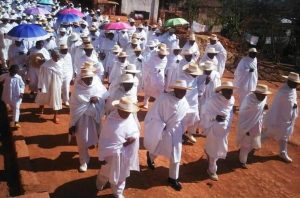The origins of traditional Chinese painting reach far back into China’s distant history. Generally speaking, works dating from before the T’ang dynasty, (618-907 A.D.), are mainly line drawings of people engaged in various activities. This was the “golden age” of human figure drawing.
By the mid-T’ang dynasty, landscape and flower-and-bird paintings began their rise to prominence. Paintings of mountains, forests, fields, and gardens have the ability to transport one away from the vexations of the material world into a peaceful, carefree realm. Because of this, landscape paintings have always been highly regarded by China’s literati and officialdom.
The flowers, grass, trees, stones, birds and other animals depicted in the lively and energetic flower-and-bird paintings are also widely admired. Thus, the landscape and flower-and-bird types of painting, together with the earlier human figure painting, comprise the three main categories of traditional Chinese painting.
The ruling and elite classes of the T’ang and Sung (960-1279 A.D.) dynasties were major supporters of Chinese painting. The creative aim behind artistic works produced in this period had more political and educational significance; in style, the works tended to be more elaborate and ornate.
The Sung dynasty court, in particularly, established a fairly well systematized academy of painting. Sung Emperor Hui Tsung a lover of fine art and painting, granted special patronage to the painters in his academy, and sponsored the training of promising painters. The academy of painting reached the zenith of its activity in this period.
However, because of gradual social, economic, and cultural changes, more and more men of letters began to take up painting, and literature came to exercise an ever-increasing influence on painting. By the time of the famous Sung poet Su Shih (1036-1101 A.D), better known as Su Tungpo, the school of “Iiterati painting” had already emerged.
By the Mongol Yuan dynasty (1271-1368 A.D.), there was no longer a formal painting academy organisation within the imperial palace, so the court style of painting declined. At this point, the “Iiterati” school of painting entered the mainstream, and the leadership in Chinese painting circles fell into the hands of literati painters.
Literati typically prefer to paint according to their own fancy and without restriction, and advocate a fresh, free, understated, and elegant style. Subject matters they are fond of includes mountains and rocks, clouds and water, flowers and trees, the “four gentlemen” (plum blossoms, orchids, bamboo, and chrysanthemums), and so forth. Because natural objects such as these are less demanding subjects to paint than the human figure, the painter can better exploit the brush and ink’s potential for free expression.
Whether Chinese painting is “realistic” is the object of frequent debate. Some may feel that it is not realistic, but such an answer tells only part of the story. Realism in Chinese painting reached its climax in the painting of the T’ang and Sung dynasties.
However, the kind of “realism” sought after in Chinese painting is not an objective reflection of the existence of an object as perceived through the sense of sight, but rather is an expression of a subjective kind of recognition or insight.
For example, no overt effort is made to represent the shadows cast by a particular type of lighting at a certain place and time in the clothing on people depicted in the Sung dynasty painting Che K’anT’u, and for this reason the painting does not have a clear three-dimensional effect.
After the painter set the lines down on the paper, he used watercolour wash techniques to achieve a chiaroscuro effect of light and dark, representing the forces of “yin” and’ ‘yang”, to express his grasp of the eternal quintessential nature of his subject. A square planter painted according to the objective principles of perspective should in theory appear longer in front and be foreshortened n the back, reflecting the perceived decrease in relative size of more distant objects. But, the front and back edges of a real planter are equal in length, and this knowledge of the physical world is incorporated into the image the painter of the Che K’an T’u created – the planter is represented as a flat surface with sides that are equal in length.
In another work, called the “Splashed-ink Immortal” by Sung dynasty artist Liang K’ai, the artist wanted to portray not just any man off the street, but an other-worldly recluse, and thus it would have been inappropriate to use an ordinary human being as a model.
The highly unusual, even weird, forms in this painting, with their bold and unbridled brush strokes, provide just the right background to set off the characteristics of this very extraordinary individual. This painting is representative of the “freehand brushstroke” school of traditional Chinese painting. The fundamental component of Chinese painting is the line, as it is in Chinese calligraphy. Because of this shared feature, these two arts have had, beginning from a very early time, a close mutual relationship.
By the time that “Iiterati” painting had become popular in the Yuan dynasty, men of letters who painted put even more conscious effort into reaffirming the link to Chinese calligraphy, and actively led a trend to fuse calligraphy and painting. And the close relationship between poetry and painting was formed under the strong influence of literature on painting. Scholar-statesmen and literati led the melding of poetry and painting, and this eventually spread to the academy of painting.
The Sung Emperor Hui Tsung is known to have used poetry to test painters on their ability to express with ink and paper the enchanted world created in written verse.
Beginning in the Sung dynasty, a small number of artists began to write the names of the giver and recipient of the painting, or to stamp their name chop, in an inconspicuous corner of the work. When “Iiterati” painting was in vogue in the Yuan dynasty, men of letters began adding personal notes on the painting, or related lines of poetry, to display their prose and calligraphic skill. This writing was now given a more prominent place on the work.
At this point, there was a new union of signature, names of giver and receiver, and notes on the painting or related verse, with the painting itself. The stamping of name chops also became established at this time. The addition of name chop impressions, in itself an art, further enriched the artistic content of Chinese painting.
Since the turn of the century, the Republic of China has experienced great political, economic, and cultural changes, and the art of painting is no exception. While traditional Chinese painting still occupies an important place in the life of modern Chinese, many painters now desire to express their experience of new times. By combining new modes of expression with traditional Chinese painting techniques, they are opening up a vast, new world of artistic expression.
– Liu Chin






